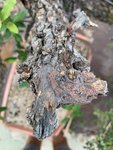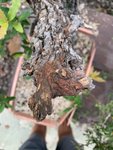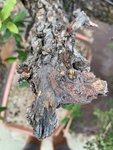Lars Grimm
Chumono
Hi All,
I almost exclusively work on deciduous so my experience with lime sulfur is limited to winter sprays. However, I have a few oaks that have some deadwood that needs some preservation and so I have started to apply some lime sulfur. I am using this brand, which says 28% calcium polysulfides which seems similar to that found on smaller bottles at bonsai merchants online.

I premoistened the wood with a little spray bottle and used a small brush to paint it at full strength onto the dead wood. The wood had all been dead for a while and was not fresh green wood. When I apply it, it takes on a chalky appearance and is very grey. I've only ever seen videos of lime sulfur applications but I thought it would be thinner and look whiter. When I use a copper brush, all the grey chalkiness comes off but it doesn't much whiter than before. In fact, there is a reddish tinge. Am I making some fundamental mistake here? Here are a few photos showing deadwood the next day after lime sulfur application and then after using a copper brush.




I almost exclusively work on deciduous so my experience with lime sulfur is limited to winter sprays. However, I have a few oaks that have some deadwood that needs some preservation and so I have started to apply some lime sulfur. I am using this brand, which says 28% calcium polysulfides which seems similar to that found on smaller bottles at bonsai merchants online.

I premoistened the wood with a little spray bottle and used a small brush to paint it at full strength onto the dead wood. The wood had all been dead for a while and was not fresh green wood. When I apply it, it takes on a chalky appearance and is very grey. I've only ever seen videos of lime sulfur applications but I thought it would be thinner and look whiter. When I use a copper brush, all the grey chalkiness comes off but it doesn't much whiter than before. In fact, there is a reddish tinge. Am I making some fundamental mistake here? Here are a few photos showing deadwood the next day after lime sulfur application and then after using a copper brush.






